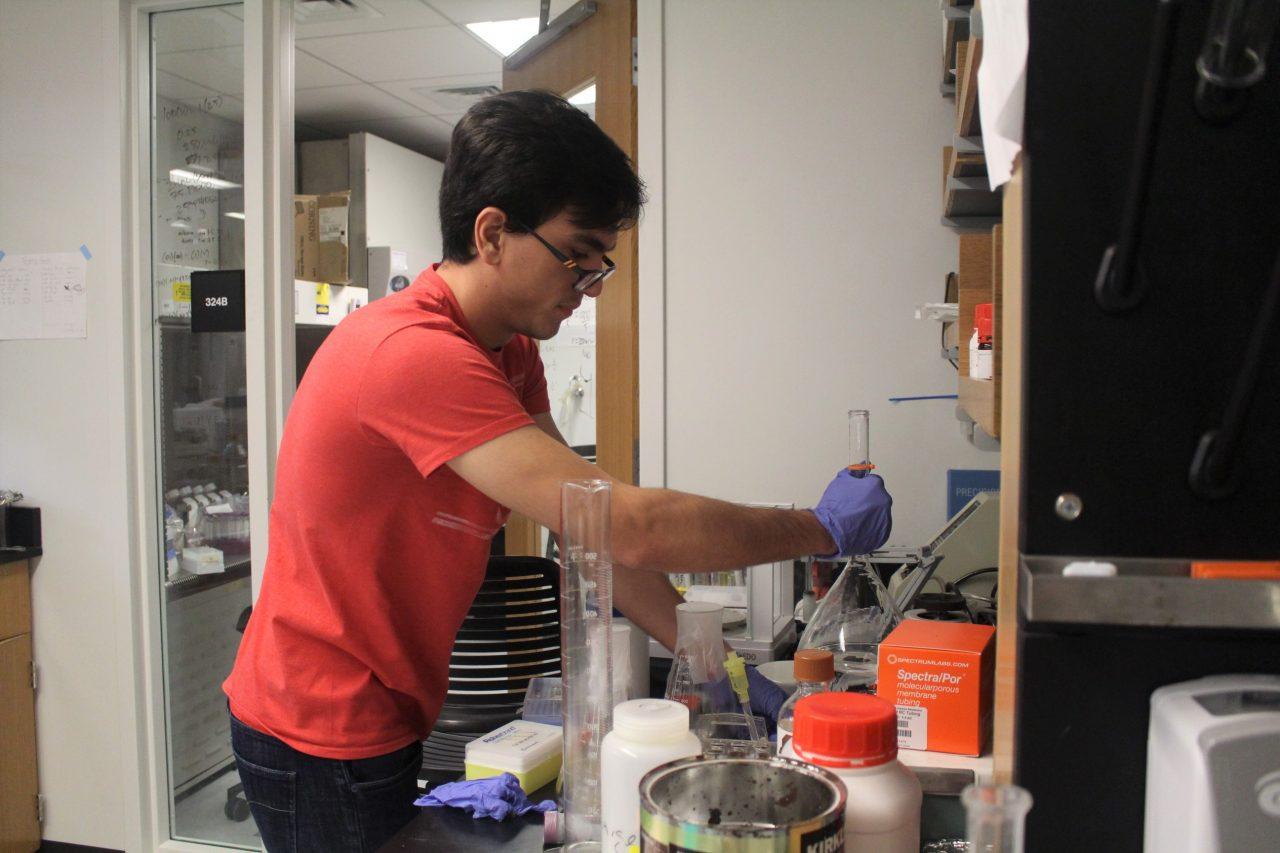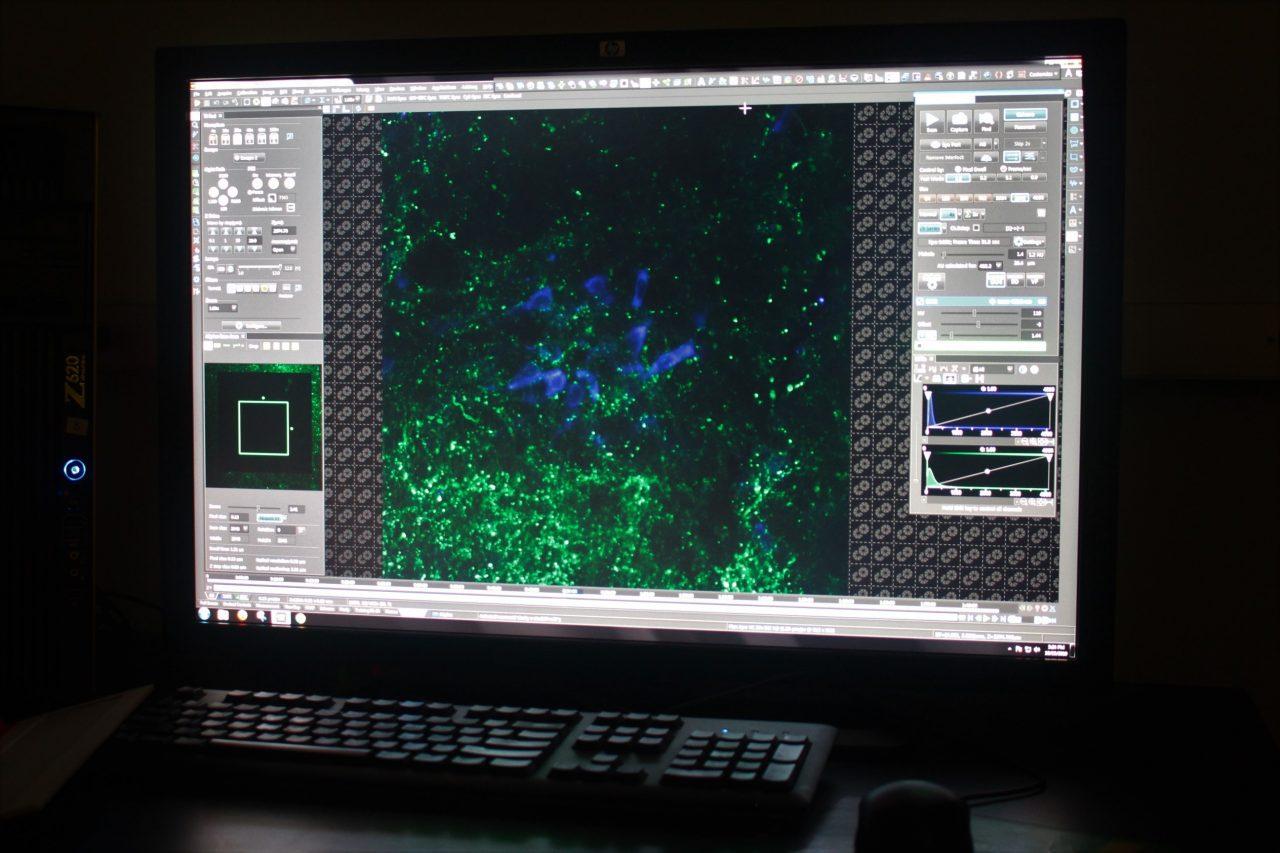Photo by Mona Mirpour
Trinity’s campus houses more animals than just cats and skunks. Mice and rats also live within the halls of the Center for Science and Innovation (CSI), all in the service of scientific research.
Seniors Juan Moreno and Aamu Karla both work with mice as research assistants for Gerard Beoudin, professor in the Department of Biology.
“My research lab is studying the initial effects of cocaine on the excitatory connections or synapses on cells that release dopamine, which begin the encoding of addiction,” Beoudin wrote in an email interview. “Our dopamine neurons are critical for learning behaviors and sequences of actions that enable obtainment of a positive result.”
The lab’s research focuses on how addiction develops in its early stages. Researchers look at dopamine cells found in the substantia nigra pars compacta area of the brain.
The experiments on the mice takes a total of three weeks, beginning when researchers inject the mice with a virus. However, this virus doesn’t make the mice sick. Instead, it acts as a genetic delivery system, allowing researchers to selectively stimulate neurons when scanning the brain through activating proteins in the virus.
“To target individual brain nuclei, a virus is used to label precise locations in the brain. Using this technique, I showed that cocaine induces different changes in synapses depending upon the innervating brain structure,” Beoudin wrote.
After the injection of the virus, the researchers check up on the mice every day to make sure they are not exhibiting any abnormal behaviors or illness. Three weeks after the initial injection of the virus, some mice are injected with cocaine while a control group is injected with saline. Twenty-four hours after that, the mice are “sacrificed,” or killed, and a slice of their brain is looked at using electrophysiology or confocal imaging. These procedures allow the researchers to see the changes in the mice’s brain in response to the cocaine.
To sacrifice the mice, researchers place the mice under anesthetic and decapitate them. Moreno estimated that he has sacrificed at least 10 mice for his research so far.
“It makes me feel sad a little bit, but I kind of just put it really deep inside of me and I don’t let it out, so I don’t express it to the point where I myself don’t know if I feel anything. It’s kind of messed up,” Moreno said.
Karla also works with mice, studying synaptic plasticity to see what kinds of cellular changes are going on in response to cocaine.
“It was definitely difficult when I first started,” Karla said. “I feel like, as bad as that sounds, that’s kind of part of the procedure now for me. So I don’t think about these things as much, but at the beginning I definitely thought about, ‘Is this humane and is it worth it?’ But our role as students is to further the research however we can.”
Students are trained how to handle the mice and make the process of sacrificing them as painless as possible.
“As long as we’re doing everything we’re supposed to do, you know, treating the mice humanely and minimize the distress felt by the mouse,” Karla said. “So as long as we uphold all the things we learned, we just have to move on and do the work that we’re here to do.”
The reason that mice are used for research is because they have been widely studied and they can be easily bred and maintained in the lab setting. Additionally, mice are good models for human biological processes. The mice’s vertebrae in general have the same neural circuits and same brain regions that are necessary for biological functions as those found in humans. The learning pathways in the brains of mice can suggest patterns about human behavior although humans do have a more developed prefrontal cortex.
“The goal is that this work … tells us how cocaine works on like a molecular level because that’s the only way we can try to figure out how to address cocaine addiction, treatment-wise,” Karla said.
Although their research is not complete, the work that Karla and Moreno have done so far suggests that there is a certain type of dopamine receptor involved in the signaling mechanisms of cocaine in the substantia nigra pars compacta area of the brain.
Getting into the specifics allows the opportunity to see what exactly cocaine is doing in the brain, and the results that this research yields can allow for future treatments to be developed.
“The main reason that we don’t have a cure for cocaine addiction or something like that is because we just don’t know enough about the brain,” Karla said. “All of this is just telling us how exactly addiction works and especially with cocaine and other drugs in active addiction.”
Student involvement in the lab research is important as they collect the majority of the data.
“As the techniques and experiments are time-consuming and technically challenging, they work together to drive their projects forward,” Beoudin wrote. “We have regular lab meetings to discuss each others projects and new research in the field. I also particularly enjoy meeting with the teams to discuss their progress.”
This weekend Karla and Moreno will attend a conference in Chicago to present and discuss their research so far.
“Yeah, I’m excited. I’m a little bit scared to present to someone that knows everything that you’re talking about and probably more about your subject than you yourself, but I’m excited,” Moreno said.








